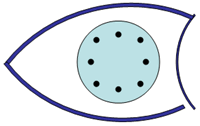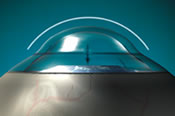Conductive Keratoplasty (CK)
Definition
Near-vision conductive keratoplasty (CK) is a refractive surgery procedure that uses radiofrequency energy to reshape the cornea and correct presbyopia.
How Does Near-vision CK Work?

The cornea plays an important role in bending the light properly as it enters the eye. CK works by increasing the curvature of the cornea in a uniform fashion and adding more light bending power to the eye's optical system. To accomplish this, a small probe is placed on the edge of the cornea, which applies radiofrequency energy to the corneal substance. The energy causes the corneal tissue immediately around the probe to shrink slightly. The probe is then applied in a ring pattern around the cornea, like marking the hours on a clock dial. The application of energy in a ring pattern causes the center of the cornea to assume a more steeply curved shape, which bends (refracts) light more strongly.
By increasing the curvature of the cornea in just one eye can treat presbyopia. The more steeply curved a cornea is, the more power it has to bend light. However if incoming light is bent too much it comes to a focus at a point in front of the retina in the middle of the vitreous of the eye. In this situation, an eye becomes slightly myopic. CK can be used to induce a mild amount of myopia in one of a person's eyes, moving the eye's natural focal point to reading distance and creating a monovision effect, helping to reduce presbyopia symptoms.
Who are candidates for Near-vision CK?
Near-vision CK can be used to treat patients who are suffering from presbyopia.
Candidates for presbyopia treatment with Near-vision CK should be:
- Suffering from the symptoms of presbyopia, which usually begin to occur
- Have very good distance vision without glasses or contact lens correction. As CK makes one eye nearsighted in order to treat presbyopia with a monovision effect, the other eye needs good distance vision for a person to see clearly in all situations.
These conditions may prevent you from undergoing Near-vision CK or other refractive surgeries. You should alert your eye surgeon if you have one or more of these conditions so that he or she can help you make the best choice about undergoing refractive surgery:
Condition:
Reason for caution:
Examination prior to Near-vision CK:
Before you arrive at the doctor's office
If you are a contact lens wearer, you should stop wearing you lens for at least 2 weeks if you wear soft contacts or 1 month if you wear hard contacts. Contact lenses can cause mild warping of the corneal shape, which can interfere with the preoperative measurements of the eye and calculations for Near-vision CK surgery.
Tests you may have at the doctor's office

The evaluation for Near-vision CK surgery typically includes a complete eye exam of the front and back of the eye, plus several additional tests. Your visual acuity with and without glasses will be tested, as well as a refraction to determine if your current vision differs markedly from the vision corrected in your current glasses. If they do differ markedly, you may need to return for another visit several weeks later for a repeat refraction to insure that your prescription is not changing. If you are presbyopic, your near reading ability will also be tested. Your eyes will be dilated in order for the physician to examine them completely. Your doctor will perform a slit lamp examination to examine the eye and the lens. A retinal exam may also be performed during the dilated examination. A second refraction may be performed after your eyes have been dilated. Lastly, measurements of the shape and curvature of your cornea will be taken to help your doctor plan the CK treatment.
Is perfect reading vision guaranteed with Near-vision CK?

Near-vision CK surgery is an extremely advanced technology for surgical vision correction. The eye is measured precisely and your surgeon will be highly skilled in performing the procedure. As such the majority of patients that undergo Near-vision CK surgery are very happy with their post-procedure vision and experience great improvement with their Near-vision. In fact, a person's happiness with their vision after the procedure is a far more important measure of success than the somewhat arbitrary measurements of near and reading vision done in the controlled setting of a doctor's office.
However, several factors may lead to a person having vision after the surgery that still requires additional help from reading glasses for near viewing activities.
Though very precise measurements and surgical technique are used for Near-vision CK surgery, the individual healing response of each patient may result in some variability of the final refractive outcome. Generally this variability is very small and people are highly satisfied with the surgery. Additional CK treatment may sometimes be used after the initial procedure to "touch up" any residual refractive error. Occasionally glasses or contacts will still be needed for some viewing situations after the surgery.
What are the risks of Near-vision CK surgery?
Though the risks of near-vision CK surgery are small, vision can be lost in several ways:
- Infection: Since cuts are made on the eye, it is possible that bacteria could gain access to the corneal tissue and cause infection. Scarring from such an infection could lead to vision loss. This is very uncommon as powerful antibiotics are used after Near-vision CK to prevent infection.
- Induced astigmatism: Near-vision CK can occasionally cause astigmatism in an eye where it was not initially present. Typically, this astigmatism causes little effect on the vision. Rarely, the vision may be affected by astigmatism from the Near-vision CK procedure, which could require glasses, contact lenses, or additional refractive surgery to correct.
- Regression of effect:In some patients, the effect of Near-vision CK may decrease with time. This regression does not cause loss of vision, as it can still be corrected with glasses or contact lenses, but can be frustrating to both the patient and doctor.
What will I experience during the CK procedure?
On the morning of your procedure, your surgeon will ask you not to wear any makeup because it could stain the cornea and increase the risk of infection. At the laser surgery center you will usually be given a Valium pill to help you feel calm during the procedure. Near-vision CK is, in general, a very simple procedure to undergo, so no Valium may even be required. The Near-vision CK procedure itself usually takes about 20 minutes or less to perform. Anesthetic eye drops are all that is required to numb the eye.
During Near-vision CK surgery an eyelid speculum is used to hold the lids open and help conduct the radio frequency energy. During surgery you may see bright, multi-colored lights, as well as blurry shapes, moving in front of the eye. Your physician will mark the cornea with an inked marking instrument to guide the placement of the treatment spots. Next, a tiny probe is placed into the cornea and the radiofrequency energy applied to the cornea causes focal shrinkage of the corneal tissue. Since the eye is numb from the anesthetic drops you will have no sensation that this is occurring.
The wounds in Near-vision CK surgery are very small, and usually heal in less then 24 hours. Antibiotic eye drops and a bandage contact lens may be placed on the eye for the first 24 hours just to help the wounds heal more comfortably. Also, a plastic shield may be placed on your eye after the surgery to help remind you not to rub the eye for the first night.
After the procedure is complete you will rest briefly in the recovery area. It is suggested that you have someone drive you home from the surgery center, and will be mandated if you were given Valium. Your eye may start to burn and feel irritated about an hour after the surgery as the numbing medicine wears off. Artificial tears can help make the eye feel more comfortable. Your surgeon may also have you start antibiotic and ibuprofen drops on the evening after your surgery.
After your surgery, you should not rub or press on the eye for at least 1 to 2 weeks. Gentle cleaning around the eye with a damp washcloth or cotton ball is fine though. Avoid getting soapy or dirty water in the eye and do not swim or use hot tubs for at least 2 weeks after the surgery.
Your doctor will see you the next day, at which point the eye usually feels comfortable. Continue using eye drops for several weeks after the surgery, and then see your doctor again in 1 to 3 weeks for a vision check. If all is well, as it typically is, your doctor will usually see you again in 6 months to a year.

